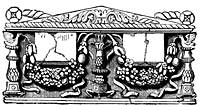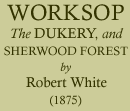< Previous | Contents | Next >
The large Drawing Room is an elegant apartment, with beautifully enriched ceiling and fine gilded chandelier, surmounted by the ducal coronet. The walls are hung with rich drab satin damask, the furniture being gilded and upholstered in blue satin damask This room contains a choice selection of articles of vertu worthy of great admiration, amongst which we may enumerate five very beautiful ormolu mounted black ebony cabinets, inlaid with brass and tortoiseshell and four most elegant pedestals, surmounted with crystal chandeliers. These most costly articles were obtained from the Doge’s Palace, Venice. Two Indian marble tables, inlaid with precious stones, and an Egyptian statuette on a malachite table, will equally command the attention of the connoisseur, as will also a most beautiful French clock, two vases of Indian filligree work, vases of exquisite design, and jewelled with precious stones, and a choice collection of Sevres Dresden, and other china.
The small Dining Room has an enriched ceiling, and on the walls are many fine works of art.
The Ante-room to Library contains many valuable works of art, amongst which will be found several portraits of historical interest. Fine marble busts of Pitt and Fox, by Nollekens; and the late Duke of Newcastle, by Dewick, will also be found here.
The Library, which is 45 feet long, 3’ feet wide, and 21 feet high, is a beautiful room fitted with rich Spanish mahogany, and contains a fine collection of English and foreign classical literature, including many rare editions by Caxton and other early printers, and some choice manuscripts. A beautiful gallery, with rich gilded railings, surround it. The marble chimney piece is of the same colour as the dark mahogany fittings; the panelling of the ceiling is painted white, lilac, and fawn, richly gilt and admirably harmonised. This apartment contains some very fine tables, cabinets, and bronzes, and Westmacott’s fine statue of Euprhrosyna. Bailey’s statue of Thetis plunging Achilles into the river Styx, and a bronze statue of Venus de Medici are prominent and beautiful objects. A Corinthian arch, the fluted columns of which are of jasper, opens into a reading room 30 feet by 22 feet, which has an octagonal front, and this opens into the east part of the terrace, from which there is a charming view of the lake and pleasure ground.
The Smoking Room contains the most chaste and beautiful chimney piece in Great Britain; it is of polished statuary marble, with exquisitely carved figures. It was purchased at Beckford’s sale, Fonthill Abbey, for £1,500. This room, and also the adjoining apartment, the Billiard Room, contains a very numerous collection of historical portraits.
The lofty Staircase is adorned with many fine paintings. The balustrades of this staircase are of wrought-iron work, with crowns and tassels hanging down between them from cords twisted into knots and festoons, and beautifully painted and relieved with gold. The stained glass windows, containing the heraldic devices of the family, add greatly to the charming effect of this part of the ducal mansion.
The lover of antiquities must not fail to see four very beautiful white marble funeral cists, probably as old as the first century after Christ.
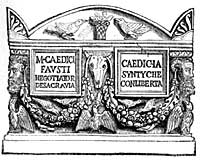
No. 1 bears the following inscription on the two first panels: M. CAEDICI FAVSTI NEGOTIATOR [IS] DE SACRA VIA CAEDICIA SYNTYCHE CONLIBERTA = Coedicia Syntyche, his fellow freedwoman [erected this to the memory] of Marcus Coedicus Faustus, Merchant of the Via Sacra.
The birds pecking at a basket of fruit between them would seem to claim a Christian artist for this work, had not the ox’s head and pendant sacrificial garland, in addition to the heads at the angles—apparently of Jupiter Ammon—pointed to heathenism; the garland intermixed with birds, below the inscription, is both rich and graceful.
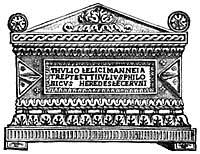
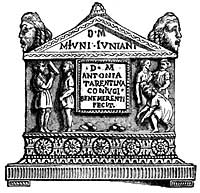
No. 2 is well-designed, both in form and details, having received much careful attention. Within a long panel, surrounded by an enriched moulding, is this inscription: TI. IVLIO FELICI MANNEIA TREPTE ET TI. PHILONICVS HEREDES FECERUNT. =To Tiberius Julius Felix, Mameia Trepte [? Threpte] and Tiberius Julius Philonicus his heirs made [this cist].
No. 3 rises from an enriched plinth, bearing first, on the pediment of its lid, the inscription D. M. M. IVNI. IVNIANI = To the Divine Manes [the tomb .] of Marcus Junius Junianus; and on a panel below, D. M. ANTONIA TARENTINA CONIVGI BENEMERENTI FECIT. = Antonia Tarentina erected [this ] to her well-deserving husband.
Four masks are placed at the corners of the lid; and on another part appears a boar, for which animal Tarentum was famous. The figures sculptured in front perhaps represent one of the funeral games.
No. 4 is longer and lower than the other, having two small panels prepared for inscriptions which never appear to have been filled up. Small fanciful pillars, or candelabra, surmounted by birds, form the angles, from which depend rich garlands of fruit.
